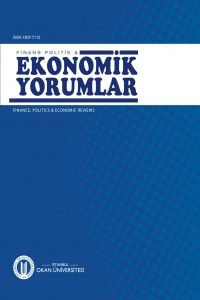İşsizliğin Azaltılmasında Kamu Kesimi Büyüklüğünün Rolü
Çalışmada, Türkiye’de kamu kesimi büyüklüğü ile işsizlik oranı arasındaki ilişkiler araştırılmıştır. 2002-2014 dönemi üçer aylık verilerin yer aldığı araştırmada uzun dönem ilişkiler için sınır testi, kısa dönem ilişkiler için Toda-Yamamoto nedensellik testi kullanılmıştır. Elde edilen bulgular, kamu büyüklüğü, reel gayri safi yurt içi hasıla ile işsizlik arasında uzun dönemli ters yönlü bir ilişkinin olduğunu göstermektedir. Ancak uzun dönem denkleminde kamu kesimi büyüklüğü katsayısı istatistiksel olarak anlamlı bulunamamıştır. Kısa dönemde ise işsizlik oranından kamu kesimi büyüklüğüne ve reel gayri safi yurtiçi hasıladan işsizlik oranına doğru tek yönlü nedensel ilişki tespit edilmiştir.
Anahtar Kelimeler:
Kamu kesimi büyüklüğü, İşsizlik, Abrams eğrisi, Ekonomoik büyüme, Eş-bütünleşme
The Role of the Goverment Size in Reducing Unemployment
In this study, the relationship between the goverment size and the unemployment rate in Turkey has been investigated. We have used 2002-2014 quarterly data and Bound test was implemented for the determination of the long run relationship and Toda-Yamamoto causality test was used for the establishment of the short run relationship. The findings indicate that there was an inverse long run relationship between unemployment, real gross domestic product and goverment size. However, the goverment size coefficient has been statistically insignificant in the long run equation. In the short run, the bilateral causal relationship from the unemployment rate to the goverment size and from the reel gross domestic product to the unemployment rate was determined.
Keywords:
Goverment size, Unemployment, Abrams curve, Economic growth, Co-integration,
___
- ABRAMS, Burton A.; (1999), “The Effect of Government Size on the Unemployment Rate”, Public Choice, vol. 99, pp. 395- 401.
- ALESINA, Alberto, SILVIA Ardagna, ROBERTO Perotti and FABIO Schiantarelli; (2002), “Fiscal Policy, Profits, and Investment”, American Economic Review, Vol. 92, No: 3, June, pp. 571-589.
- ARTAN, Seyfettin ve METİN Berber; (2004), “Kamu Kesimi Büyüklüğü ve Ekonomik Büyüme İliskisi: Çoklu Ko-Entegrasyon Analizi”, Cumhuriyet Üniversitesi İktisadi ve İdari Bilimler Dergisi, Cilt 5, Sayı 2, ss. 13–29.
- ASCHAUER, David Alan ;(1989), “Is Public Expenditure Productive?”, Journal of Monetary Economics, Vol, 23, pp. 177– 200.
- ASLAN, Alper ve FERİT Kula; (2010), “Kamu Sektör Büyüklüğüİşsizlik İlişkisi: Abrams Eğrisi’nin Türkiye Ekonomisi İçin Testi”, Maliye Dergisi, Sayı 159, Temmuz-Aralık, ss. 155-166.
- AYSU, Ahmet ve GÖKHAN Dökmen; (2011), “An Investigation on the Relationship between Government Size and Unemployment Rate: Evidence from OECD Countries”, Sosyoekonomi, Sayı 16, ss. 179-190.
- BARRO, Robert J.; (1991), “Economic Growth in a Cross Section of Countries”, The Quarterly Journal of Economics, Vol. 106, No: 2, May, pp. 407-443.
- BERBER, Metin; (2011), İktisadi Büyüme ve Kalkınma, Derya Kitabevi, 4. Baskı, Trabzon.
- CHEN, Tung Sheng and CHIANG C. Lee; (2005), “Government Size and Economic Growth in Taiwan: A Threshold Regression Approach”, Journal of Policy Modeling, Vol. 27, No: 9, December, pp. 1051–1066.
- CHRISTOPOULOS, Dimitris K., JOHN Loizides, and EFTHYMIOs G. Tsionas; (2005), “The Abrams Curve of Government Size and Unemployment: Evidence from Panel Data”, Applied Economics, Vol. 37, No: 10, pp. 1193-1199.
- CHRISTOPOULOS, Dimitris K. and EFTHYMIOS G Tsionas; (2002), “Unemployment and Government Size: Is there any Credible Causality?”, Applied Economics Letters, Vol. 9, No: 12, pp. 797-800.
- DALAMAGAS, Basil; (2000), “Public Sector and Economic Growth: the Greek Experience”, Applied Economics, Vol. 32, No: 3, pp. 277-288.
- DAR, Atul A. and, Sal AMİRKHALKHALI; (2002), “Government Size, Factor Accumulation, and Economic Growth: Evidence from OECD Countries”, Journal of Policy Modeling, Vol. 24, No: 7-8, November, pp. 679–692.
- DAVERI, Francesco and Guıdo TABELLINI; (2000), “Unemployment, Growth and Taxation in Industrial Countries”, Economic Policy, Vol. 15, No: 30, April, pp. 49-104.
- DICKEY, David A. and Wayne A. FULLER; (1979), “Distribution of the Estimators for Autoregressive Series with a Unit Root”, Journal of the American Statistical Association, Vol.74, June, pp. 427-431.
- ENDERS, Walter; (2004), Applied Econometric Time Series, 2nd Edition, John Willey&Sons, USA.
- ENGEN, Eric M.and Jonathan SKINNER; (1992), “Fiscal Policy and Economic Growth”, NBER Working Paper Series, No: 4223, December, pp. 1-48.
- ENGLE, Robert F. and C.W.J. GRANGER; (1987), “Cointegration and Error-Correction: Representation, Estimation and Testing”, Econometrica, Vol.55(2), pp.251-276.
- ISSN: 1307-7112
- Başlangıç: 1963
- Yayıncı: İstanbul Okan Üniversitesi
Sayıdaki Diğer Makaleler
Bankalarda Kredi Arzını EtkileyenFaktörler
Halime Temel NALIN, Selvihan TAŞDELEN
İşsizliğin Azaltılmasında Kamu Kesimi Büyüklüğünün Rolü
Türk Gayrimenkul YatırımOrtaklıklarında Rekabet Yapısı
Hümeyra BURUCU, Filiz Yıldız CONTUK
Döviz Kurunun Temel Makro Ekonomik Değişkenlerle İlişkisi: Türkiye ve BRICS Ülkeleri Karşılaştırması
